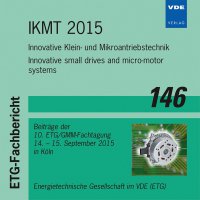Increasing the torque density of low power drives using Vernier out runner motors in intralogistic industries
Konferenz: IKMT 2015 - 10. ETG/GMM-Fachtagung Innovative Klein- und Mikroantriebstechnik
14.09.2015 - 15.09.2015 in Köln, Deutschland
Tagungsband: IKMT 2015
Seiten: 4Sprache: EnglischTyp: PDF
Persönliche VDE-Mitglieder erhalten auf diesen Artikel 10% Rabatt
Autoren:
Grabs, Volker; Thesseling, Matthias (Lenze SE, Hamelin, Germany)
Inhalt:
The demands of “Industry 4.0”-plants require the optimization of intralogistic conveying systems. This leads to changeable and flexible conveying systems which are able to perform different material handling tasks like sorting or buffering. To reach this aim a novel concept for conveying systems called “conveyor matrix” has been proposed [1]. The matrix itself consists of many conveying elements. The mechanical energy, necessary for transporting goods, is converted in the conveyor drive. Each conveying element is able to change the conveying direction through an additional swivel drive. In this article only the conveyor motor will be described. This is the most interesting one because of the high torque density. The high requirements will be met by a Vernier motor consisting of a stator/modulator and an external rotor [2]. The motor has a stator winding with 2ps poles, a modulator with Ts teeth and a rotor with a different pole-pair number pr. The relation between these numbers is |Ts-pr|= ps . In this special case the conveyor motor uses a distributed 3-phase 2-pole winding system in combination with a 22-pole permanent magnet rotor. To adjust the different magnetic fields a modulator between rotor and stator is used. The number of modulator teeth is 12, which is exactly the number of the stator teeth. It is possible to combine both elements in one part, resulting in a very compact motor. Thanks to the inner stator design it is possible to put the winding end turns radially across the stator. The end turns will be shorter compared with circumferentially arranged windings of an outer stator motor. The rotor is made out of a simple steel roll with magnets glued to the inside. The conveyor goods will roll directly on the outside surface of the rotor. As in a wheel hub motor a shaft or coupling is not necessary for this kind of drive. Based on the small dimensions (approx. 50mm in diameter and length) of the motor an encoder would decrease the volume of iron and consequently the maximum torque. That is why the overall drive concept will be based on encoderless control. The quality of the rotor angle detection at low speeds depends on the ability to observe the motor. Anisotropies in d-axis and q-axis inductances are used to detect the rotor position. To increase the anisotropy of the motor, different rotor geometries will be analyzed for an array of current and saturation states.


